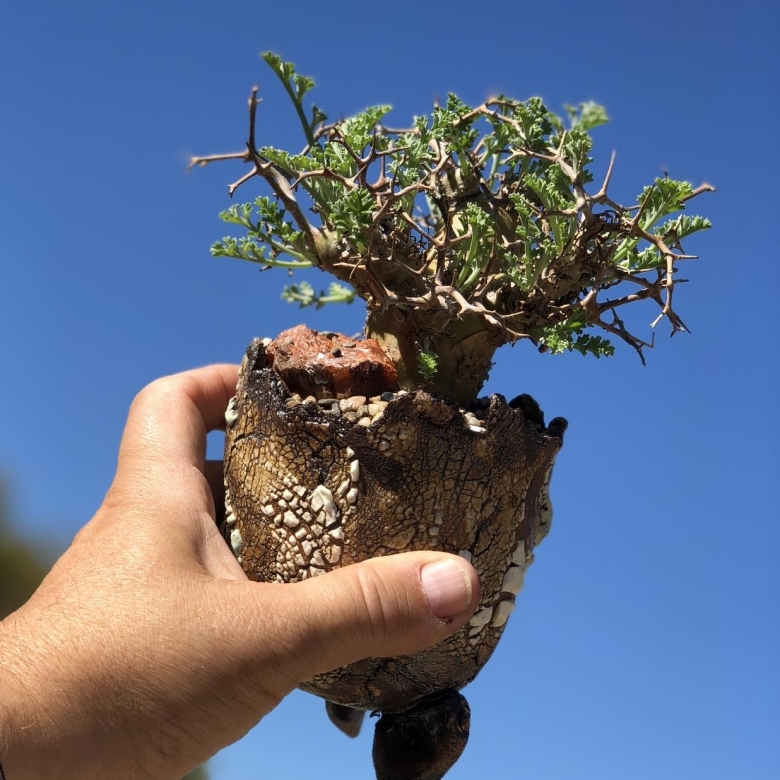Accepted Scientific Name: Pelargonium crithmifolium Sm.
Icon. Pict. Pl. Rar. 1: t. 13. 1793 [Nov 1793] Sm.

Geranium crithmifolium (Pelargonium crithmifolium) Photo by: © Plantemania
Origin and Habitat: The distribution range is fairly wide, extending from Southern Namibia, to South Africa (Northern Cape, Western Cape).
Habitat and ecology. Pelargonium crithmifoliumSN|35424]]SN|35424]]is a winter growing species. It favours hot, dry, rocky habitats and survives the hot dry summer months by its leaves becoming dried and withering away, and by living on the moisture stored in its thick succulent stems and thick tuberous roots. The plant is able to photosynthesise through its greenish bark. The winter rains ( 80 mm per annum ) revive the plants and growth begins again. Flowering time is anywhere winter ( from May to October). Its slow growth pattern may also protect it from seasonal fluctuations. P. crithmifoliumis able to survive temperatures of -4 °C. It is pollinated by bees and bumble bees. The seeds are carried by the wind some distance away from the parent plant.
Synonyms:
See all synonyms of Pelargonium crithmifolium
back
Accepted name in llifle Database:Pelargonium crithmifolium Sm.Icon. Pict. Pl. Rar. 1: t. 13. 1793 [Nov 1793]Synonymy: 7
back
Common Names include:
ENGLISH: Samphire-leaved pelargonium
AFRIKAANS (Afrikaans): jakopregopbossie, dikstam-malva, gnom, kana
Description: Pelargonium crithmifolium is a perennial, shrubby, stems succulent, up to 50-120 cm tall with a succulent, knobbly stem bearing the remains of persistent leaf bases. The branches are swollen at the nodes. It is a very straggling plant with panicled inflorescence and fleshy, narrow and divided foliage held on longish petioles. The plants generally grow very slowly. This is especially the case where plants are cultivated from seed.
Derivation of specific name: The samphire-leaved pelargonium has leaves which resemble the sea samphire: Crithmum and folium is the Latin for leaf, hence the specific epithet crithmifolium.
Stem: Normally branched, thick, succulent, knobbly, greenish yellow with peeling bark, to 50-120 cm tall (and even more in cultivation). The branches swollen at the nodes.
Leaves: Tightly bunched together on the tips of the branches, pinnatisect to bipinnatisect (divided into smaller leaflets), succulent on longish petioles, glabrous or pubescent, the segments narrow-linear. Stipules minute, cordate. The leaves, when crushed, have a ginger and nutmeg smell. P. crithmifolium is summer deciduous.
Inflorescence: Large and much-branched, Peduncles persistent, downy and forming a system of hard, repeatedly and divaricate dichotomously branched spines: Part-inflorescence (umbels), naked, with 4-6(-8) flowers each, and with oblong, obtuse, small bracts. Pedicels downy or glabrescent; longer than the calyx-tube.
Flowers:Calyx-segments linear-oblong, obtuse. Petals 5, white, upper 2 sharply reflexed with crisped base and purple markings, lower 3 smaller, tips bent towards the front. Fertile stamens 5, of equal size. Pollen orange.
Seeds: Once the sedd reach the ground it bores its way into the soil. This is possible due to the corkscrew tail attached to the end of the seed. As the wind blows, so the corkscrew turns, much like a drill bit.
Bibliography: Major references and further lectures
1) Urs Eggli “Illustrated Handbook of Succulent Plants: Dicotyledons” Springer, 2002
2) W. H. Harvey, “Flora Capensis”, Vol 1, 1894
3) Van der Walt, J.J.A., “Pelargoniums of Southern Africa” Fischer, 1979
4) Van der Walt, J.J.A., “Pelargoniums of Southern Africa”, vol. 1. Juta, Cape Town, 1977
5) “Geraniums Around the World”, International Geranium Society., 1986
6) Goldblatt, P. and Manning, J.C. 2000. “Cape Plants: A conspectus of the Cape Flora of South Africa”. Strelitzia 9. National Botanical Institute, Cape Town.
7) Foden, W. & Potter, L. 2005. Pelargonium crithmifolium Sm. National Assessment: Red List of South African Plants version 2017.1. Accessed on 2018/10/25
8) Powrie, L., “Common names of Karoo plants”. Strelitzia 16. National Botanical Institute, Pretoria.
9) Smith, C.A. 1966. “Common names of South African plants”. Memoirs of the Botanical Survey of South Africa No. 35. Government Printer, Pretoria.
10) “Pelargonium crithmifolium” in: Plantzafrica <http://pza.sanbi.org/pelargonium-crithmifolium> an Oliver - Karoo Desert National Botanical Garden, August 2004 . web 16 October 2018
Cultivation and Propagation: Propagation can be accomplished either by cuttings or seed. If one wishes to propagate by cuttings, it is advisable to harvest material in early autumn when the plant is starting to produce its first set of leaves of the season. Under ideal conditions it can take five years for a plant to reach a height of 1 m. They can live for more than forty years.










